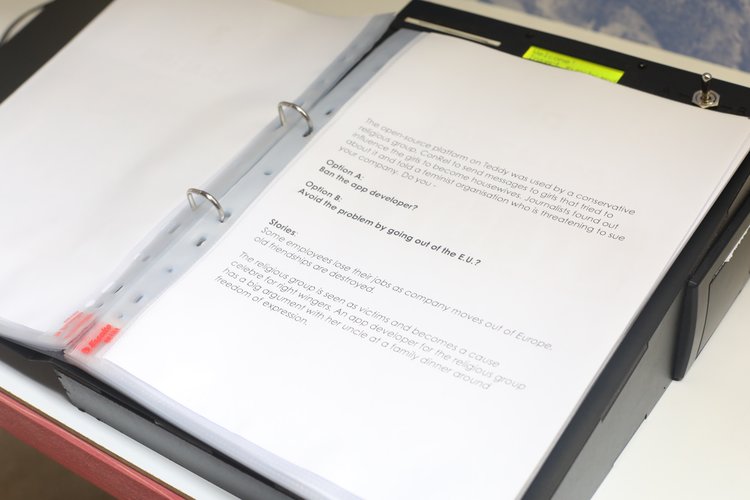Bear & Co
Connecting Merchants and Locations through Market Days
- Client: Copenhagen Institute of Interaction Design (CIID Research) / VIRT-EU
- Year: 2019
- Role: Principal Investigator & Designer
- Tags: Ethics, IoT, Interaction Design, Exhibition
Project Overview
Bear & Cowas an interactive installation designed by the Copenhagen Institute of Interaction Design (CIID) as part of the VIRT-EU research project, aiming to embed ethical reasoning into the process of designing connected devices. First staged at Ars Electronica in 2018 and later demonstrated at ACM CHI 2019, Bear & Co allowed participants to simulate working at a fictional IoT startup, confronting them with real-world ethical dilemmas.
Motivation & Opportunity
Emerging technologies often reach the market without sufficient ethical reflection. Recognising this, our team saw an opportunity to create a tangible, immersive experience that could encourage developers, designers, and stakeholders to consider ethics proactively.Bear & Cowas designed to bridge the gap between abstract ethical frameworks and practical, everyday decision-making.
My Role & Team Dynamics
As thePrincipal Investigator and Lead Experience Designer, my responsibilities included:
Conceiving ethical dilemma scenarios.
Developing the custom punch-card mechanic and participant interactions.
Designing reflection prompts and guiding participant debriefs.
Collaboration was multidisciplinary, involving ethicists, lawyers, social scientists, policymakers, and designers across institutions, including CIID, IT University of Copenhagen, Uppsala University, Politecnico di Torino, LSE, and Open Rights Group. Decision-making was collaborative and iterative, aligning scholarly insights closely with interactive prototypes.
Constraints & Challenges
The project faced several constraints:
Budget and Timeline: Limited resources and a tight schedule required rapid iteration and effective prioritisation.
User Clarity: Early testing showed participants struggled initially to understand the punch-card mechanism, requiring more precise guidance.
On-site Reliability: The technical setup had to withstand constant interaction within a noisy exhibition environment.
These limitations sharpened our focus, leading to simpler, clearer interactions without compromising the depth of the ethical experience.
Research & Exploration
We conducted extensive literature reviews on ethical frameworks, ran workshops with IoT startups, and piloted the installation with design students to refine interaction clarity. Inspirations were drawn from serious games and role-playing simulations, helping us realise that scenario prompts had to be jargon-free and succinct to maintain visitor engagement.
Design & Interaction Approach
Participants began their journey by stating their values through a unique punch card . They navigated ethical dilemmas by choosing between two options, physically engaging through tactile switches . Each decision potentially created tension between their stated values and their actual choices, culminating in a printed receipt highlighting any misalignments .
Key design principles guiding our work included:
Clarity of Ethical Tension: Ensuring participants recognise conflicts between their values and actions.
Low-Friction Interaction: Physical interactions and simple interfaces facilitated intuitive engagement.
Reflective Space: Dedicated areas allowed participants to reflect and discuss outcomes in depth.
Initial feedback led us to streamline the scenarios, shorten session lengths, clarify instructions, and improve user experiences and deeper ethical reflections.
Technical Architecture & Systems
The technical implementation emphasised simplicity and reliability:
Punch-card System: Adapted an off-the-shelf punch-card reader to trigger scenario prompts and log user choices .
Interactive Displays: LCD screens provided clear instructions and scenario narratives, enhancing usability.
Physical Receipts: Customised printed receipts provided tangible feedback summarising participant decisions.
This straightforward yet robust setup ensured seamless operation during exhibitions .
Workflow & Process
Our daily workflow involved rapid prototyping, frequent feedback sessions, and iterative testing cycles. Prioritisation was guided by a core commitment to capturing essential ethical tensions. Adjustments were continuously integrated based on user tests, significantly refining the installation’s usability and impact.
A facilitator guide was later introduced to assist staff in supporting participants through their ethical journey.
Major Pivots & Adaptations
Pilot testing revealed sessions were initially too long and complex. We responded by:
Cutting less critical scenarios.
Simplifying language for accessibility.
Enhancing signage for more precise guidance.
These changes significantly increased participant completion rates and improved the quality of ethical reflection.
Final Outcome & Reception
Bear & Co successfully debuted at Ars Electronica and ACM CHI, engaging hundreds of visitors, IoT researchers, and students. Participants praised its immersive quality and the compelling way ethical tensions surfaced and discussed.
It earned anHonorary Mention in the Experimental Categoryof the Fast Company 2019 Innovation by Design Awards, alongside Nike, Microsoft, and Mastercard projects.
Personal Reflection & Learnings
I am particularly proud of integrating rigorous ethical research with interactive design, successfully translating complex theoretical frameworks into meaningful user experiences. The primary challenge was balancing depth with user engagement, an area in which I significantly improved my skills through the project.
If I were to approach the project again, I would incorporate lightweight analytics and a companion app for deeper post-experience reflection.
Impact & Recognition
Bear & Co was recognised as an innovative contribution to ethical design thinking, inspiring similar research efforts worldwide. It demonstrated the power of experiential tools to engage technology creators in crucial ethical dialogues effectively.

bearco_01
Operator’s manual page displayed in a binder, presenting a dilemma scenario where participants choose option A or B via a physical switch.

bearco_02
The Bear & Co operator’s station installation: a scaffold-style frame with illuminated workspace and two terminals for participant engagement.

bearco_03
Printed receipt emerging from the station, summarizing the participant’s choices and flagging any value–decision misalignments.

bearco_04
Close-up of the station’s LCD screen prompting “Welcome! Insert Punchcard,” guiding participants through the sign-in interaction.

bearco_05
Participant hands holding both the punched value card and the printed receipt side by side, illustrating the values-in-action workflow.
